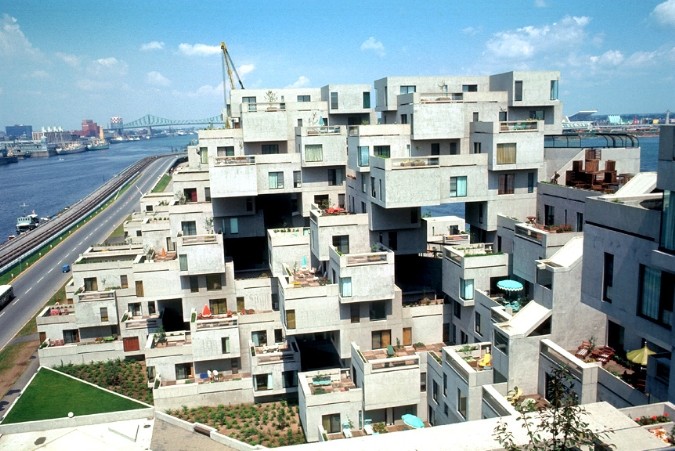

Image from WorldsFairPhotos.com, the Bill Cotter collection, with our sincere thanks.
Habitat 67
|
Since Man first moved out of his caves, he has tested many forms of
shelter: crude huts of mud, tents with skin covers, squared logs and
blocks of stone.
Around a group of such dwellings - always near water - a village would grow, then perhaps a town, with winding paths leading to the focal point of well or water's edge. Today, Habitat 67 in Cité du Havre reveals to the fullest the extent to which man has used his ingenuity in combining shelter with all the attributes of modern life, in an urban world in which living space is at a premium. It unites the advantages of apartments, by housing many families in a small area. It answers the suburban dream of gardens. And it places every home within walking distance of stores on sheltered streets. To the visitor approaching Habitat 67 from almost any direction, the first impression is one of a series of terraces, rising one on the other, in set-back steps, to a height of twelve stories. The most distinctive features of Habitat 67 are the manner in which terraces and homes are combined for economy of construction, and the system of roads and pedestrian streets which serve each home on the various levels. The actual housing area contains 158 housing units in 20 types, ranging from a 1-bedroom 600 ft. square unit to a 4-bedroom house of 1,700 sq. ft. The houses were put together by the use of 354 modular construction units, each 17'6" by 38'6" by 10' high, precast of concrete. After casting, the modular units were taken to a finishing area, where kitchens, bathrooms, window frames, insulation, fixtures, etc. were installed. The unit - weighing 70-90 tons - was then lifted into place by crane. In grouping the units, the garden of each home is formed on the roof of the unit below. Each garden is provided with planters, automatically irrigated and fertilized from a central source. The occupants choose flowers and shrubs to suit their fancy. At the ground level, a service road system connects all service areas and parking facilities. One level above the service roads is a pedestrian plaza, and above that plastic-sheltered streets which connect all parts of the project through walk-ways and bridges. At no time is it necessary for a pedestrian to cross the service roads. To reach the homes on the upper levels there are three vertical cores, where the elevators serve the horizontal pedestrian streets. For the younger children, unable to go alone to the parks on the ground, there are playgrounds on the upper levels. In its broad concept and all its details, Habitat 67 is an important contribution to the study of Man in the Community. Click here to see a model to scale of Habitat. Click here to see a map of the Habitat floor plan. Click here for a first-hand report of a couple who lived in Habitat along with additional photographs. Click here for the actual "Planning and Architectural Drawings" of Habitat from McGill University, Montréal. Click here for photographs of Prefabrication and Equipment examples used to build Habitat. |
1/15